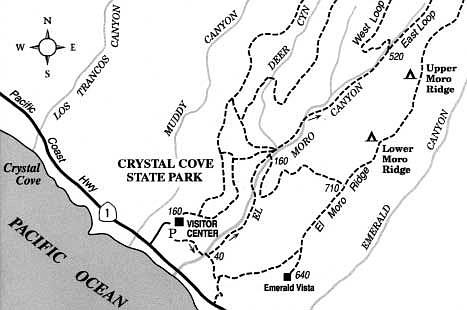 Facebook
Facebook
 X
X
 Instagram
Instagram
 TikTok
TikTok
 Youtube
Youtube
Crystal Cove State Park preserves one of the last large, undisturbed parcels of open space along the Orange County coast. Besides containing a three-mile stretch of bluffs and ocean front, the park reaches back into the San Joaquin Hills to encompass the entire watershed of El Moro Canyon -- over four square miles of natural ravines, ridges, and marine-terrace formations. The entire area was swept by wildfire in October 1993, but intervening rainy years have promoted a vigorous regrowth of the vegetation. After a string of dry years, the current relatively wet spring season is already producing the best wildflower display seen hereabouts since 1997.
Upper El Moro Canyon is far and away the most beautiful attraction in the park's backcountry section, east of Pacific Coast Highway. On foot or by mountain bike, you may cruise by thickets of willow, toyon, elderberry, and sycamore, all brightly illuminated by the sun; then you plunge into cool, dark, cathedral-like recesses overhung by the massive limbs of live oaks. In one such recess, several shallow caves, adorned with ferns at their entrances, pock a sandstone outcrop next to the road. Before the establishment of the California missions, coast-dwelling Indians gathered acorns, seeds, and wild berries in this canyon. These foods, coupled with the abundant marine life nearby, provided a balanced and healthy diet.
To get to El Moro Canyon by the shortest route, start at the park's visitors' center, located off Pacific Coast Highway about two miles north of Laguna Beach. A $5 fee is charged for parking there. Take the trail leading from the parking-lot entrance southwest across a grassy flat and down into shallow El Moro Canyon, alongside a trailer park that will soon be converted into a drive-in campground for the state park.
When you reach the El Moro Canyon bottom, turn left and walk uphill on a mostly easy gradient. Other trails intersect left and right; you simply stay in the canyon bottom. At a point about three miles up the canyon, the canyon-bottom trail, now called the East Loop, leaves the lushness of the canyon floor and starts climbing very sharply to a ridge above. This is a good spot to turn around and head back the way you came -- the easy way. Should you wish to extend your hike or bike ride, you can loop north and return to your starting point using any of several ridge-running trails.


Crystal Cove State Park preserves one of the last large, undisturbed parcels of open space along the Orange County coast. Besides containing a three-mile stretch of bluffs and ocean front, the park reaches back into the San Joaquin Hills to encompass the entire watershed of El Moro Canyon -- over four square miles of natural ravines, ridges, and marine-terrace formations. The entire area was swept by wildfire in October 1993, but intervening rainy years have promoted a vigorous regrowth of the vegetation. After a string of dry years, the current relatively wet spring season is already producing the best wildflower display seen hereabouts since 1997.
Upper El Moro Canyon is far and away the most beautiful attraction in the park's backcountry section, east of Pacific Coast Highway. On foot or by mountain bike, you may cruise by thickets of willow, toyon, elderberry, and sycamore, all brightly illuminated by the sun; then you plunge into cool, dark, cathedral-like recesses overhung by the massive limbs of live oaks. In one such recess, several shallow caves, adorned with ferns at their entrances, pock a sandstone outcrop next to the road. Before the establishment of the California missions, coast-dwelling Indians gathered acorns, seeds, and wild berries in this canyon. These foods, coupled with the abundant marine life nearby, provided a balanced and healthy diet.
To get to El Moro Canyon by the shortest route, start at the park's visitors' center, located off Pacific Coast Highway about two miles north of Laguna Beach. A $5 fee is charged for parking there. Take the trail leading from the parking-lot entrance southwest across a grassy flat and down into shallow El Moro Canyon, alongside a trailer park that will soon be converted into a drive-in campground for the state park.
When you reach the El Moro Canyon bottom, turn left and walk uphill on a mostly easy gradient. Other trails intersect left and right; you simply stay in the canyon bottom. At a point about three miles up the canyon, the canyon-bottom trail, now called the East Loop, leaves the lushness of the canyon floor and starts climbing very sharply to a ridge above. This is a good spot to turn around and head back the way you came -- the easy way. Should you wish to extend your hike or bike ride, you can loop north and return to your starting point using any of several ridge-running trails.
